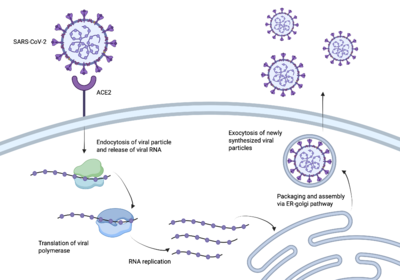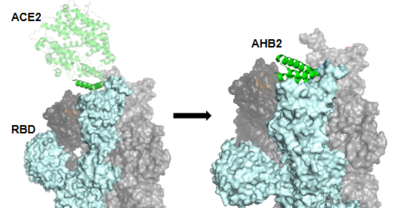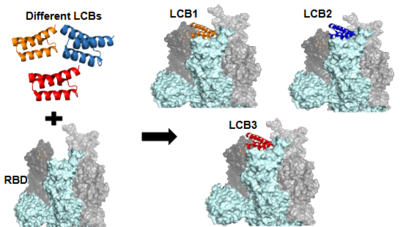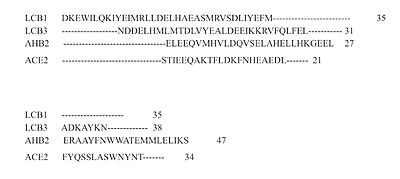New Test
From Proteopedia
| (4 intermediate revisions not shown.) | |||
| Line 6: | Line 6: | ||
SARS-CoV-2 better known as Covid-19 sent the world into a global pandemic due to its rapid transmission and infection <ref name=”WHO”>https://www.who.int/europe/emergencies/situations/covid-19</ref>. In order to create a vaccine, it was essential to understand how SARS-CoV-2 infected us. | SARS-CoV-2 better known as Covid-19 sent the world into a global pandemic due to its rapid transmission and infection <ref name=”WHO”>https://www.who.int/europe/emergencies/situations/covid-19</ref>. In order to create a vaccine, it was essential to understand how SARS-CoV-2 infected us. | ||
| - | The enzyme angiotensin converting enzyme 2 <scene name='10/1077473/Ace2_only/1'>(ACE2)</scene> is attached to our cell membranes and then can be bound to a receptor binding domain <scene name='10/1077473/Rbd_only/2'>(RBD)</scene> <ref name="Borkotoky">DOI:10.1007/s11033-022-08193-4</ref>. The virus, SARS-CoV-2, enters our bodies containing a spike protein protruding from the viral membrane. The RBD on the end of the spike protein<scene name='10/1076049/Ace2andrbd/1'>binds to ACE2</scene> giving SARS-CoV-2 the ability to enter our host cells <ref name=”Jackson”>DOI:10.1038/s41580-021-00418-x</ref>. Once the spike protein has access to our host cells, it is able to further infect our cells and spread the virus throughout our bodies, causing us to get sick. Figure 1 demonstrates the path SARS-CoV-2 takes to get into our cells. In order to create an effective vaccine, the pathway between the spike protein and the RBD needed to be [https://www.sciencedirect.com/science/article/pii/S0166354223000190 interrupted]. | + | The enzyme angiotensin converting enzyme 2 <scene name='10/1077473/Ace2_only/1'>(ACE2)</scene> is attached to our cell membranes and then can be bound to a receptor binding domain <scene name='10/1077473/Rbd_only/2'>(RBD)</scene> <ref name="Borkotoky">DOI:10.1007/s11033-022-08193-4</ref>. The virus, SARS-CoV-2, enters our bodies containing a spike protein protruding from the viral membrane. The RBD on the end of the spike protein <scene name='10/1076049/Ace2andrbd/1'>binds to ACE2</scene> giving SARS-CoV-2 the ability to enter our host cells <ref name=”Jackson”>DOI:10.1038/s41580-021-00418-x</ref>. Once the spike protein has access to our host cells, it is able to further infect our cells and spread the virus throughout our bodies, causing us to get sick. Figure 1 demonstrates the path SARS-CoV-2 takes to get into our cells. In order to create an effective vaccine, the pathway between the spike protein and the RBD needed to be [https://www.sciencedirect.com/science/article/pii/S0166354223000190 interrupted]. |
| Line 20: | Line 20: | ||
The first mini-binder to be created to combat COVID-19 is called AHB2. In order to ensure that the mini-binder would bind to the same RBD that the ACE2 was bound to, AHB2 was designed by looking at the specific sequence of ACE2 to find the alpha-helix that makes interactions with the spike receptor binding domain. This design process is referred to as the Rosetta Blueprint protein design. Figure 2 shows the RBD trimer with one part of ACE2 being used for the reference alpha helix to create AHB2. <ref name="Cao">DOI:10.1126/science.abd9909</ref>. | The first mini-binder to be created to combat COVID-19 is called AHB2. In order to ensure that the mini-binder would bind to the same RBD that the ACE2 was bound to, AHB2 was designed by looking at the specific sequence of ACE2 to find the alpha-helix that makes interactions with the spike receptor binding domain. This design process is referred to as the Rosetta Blueprint protein design. Figure 2 shows the RBD trimer with one part of ACE2 being used for the reference alpha helix to create AHB2. <ref name="Cao">DOI:10.1126/science.abd9909</ref>. | ||
| - | |||
[[Image:LCB_Method.png|400 px|right|thumb|Figure 3:The use of the De Novo protein design to create the LCB1 and LCB3 inhibitors.]] | [[Image:LCB_Method.png|400 px|right|thumb|Figure 3:The use of the De Novo protein design to create the LCB1 and LCB3 inhibitors.]] | ||
| Line 31: | Line 30: | ||
<scene name='10/1078099/Ahb2_internal_stability/2'>Nonpolar core of AHB2</scene> | <scene name='10/1078099/Ahb2_internal_stability/2'>Nonpolar core of AHB2</scene> | ||
| - | <scene name='10/ | + | <scene name='10/1078118/Lcb1_internal_stability/1'>Nonpolar core of LCB1</scene> |
| - | <scene name='10/ | + | <scene name='10/1078118/Lcb3_internal_stability/1'>Nonpolar core of LCB3</scene> |
==Binding Site and Interactions== | ==Binding Site and Interactions== | ||
| Line 58: | Line 57: | ||
| - | + | </StructureSection> | |
==References== | ==References== | ||
Current revision
| |||||||||||
References
Cao, L., Goreshnik, I., Coventry, B., Case, J.B., Miller, L., Kozodoy, L., Chen, R.E., Carter, L., Walls, A.C., Park, Y., Strauch, E., Stewart, L., Diamond, M.S., Veesler, D., & Baker, D. De novo design of picomolar SARS-CoV-2 mini protein inhibitors. Science 370, 426-431 (2020). https://doi.org/10.1126/science.abd9909
https://www.who.int/europe/emergencies/situations/covid-19
https://www.nature.com/articles/s41580-021-00418-x#citeas
https://www.science.org/doi/10.1126/science.abd9909
Zhang, Haoran et al. Advances in developing ACE2 derivatives against SARS-CoV-2. The Lancet Microbe, Volume 4, Issue 5, e369 - e378 (2023). https://doi.org/10.1016/S2666-5247(23)00011-3
https://www.cdc.gov/vaccines/basics/explaining-how-vaccines-work.html\
https://en.wikipedia.org/wiki/Vaccine
PDB Files
[1]https://www.rcsb.org/structure/7UHB
Student Contributors
- Giavanna Yowell
- Shea Bailey
- Matthew Pereira




